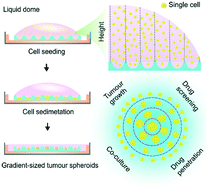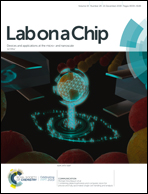Gradient-sized control of tumor spheroids on a single chip†
Abstract
Multicellular tumor spheroids are attracting more attention as a physiologically relevant in vitro tumor model for biomedical research. The size of spheroids is one of the critical parameters related to drug penetration and cellular responses. It remains challenging to generate a large number of gradient-sized spheroids in one culture vessel. Here, a liquid-dome method was used to simultaneously produce more than 200 gradient-sized spheroids on an agarose chip. Surface tension effect was used to modulate the liquid spatial distribution and achieve a range of spheroid sizes. MCF-7 cells formed multiple spheroids on the chips for concept validation. It showed that different configurations of the liquid domes exhibited different levels of size control. Relative to the smallest spheroids in the configuration, hemispheric and square domes produced spheroids up to 3.4 and 12.8-fold larger in area, respectively. In addition, the co-culture of MCF-7 and fibroblasts helped to elucidate the tendency of fibroblasts towards the spheroid center. Other size-dependent behaviors were profiled; larger spheroids behaved differently from smaller spheroids in terms of spheroid growth, drug penetration and cellular responses. This method breaks the boundary between the preparation of gradient-sized spheroids and significant time/labour demand. It can be useful for drug screening and in vitro tumor modelling.



 Please wait while we load your content...
Please wait while we load your content...